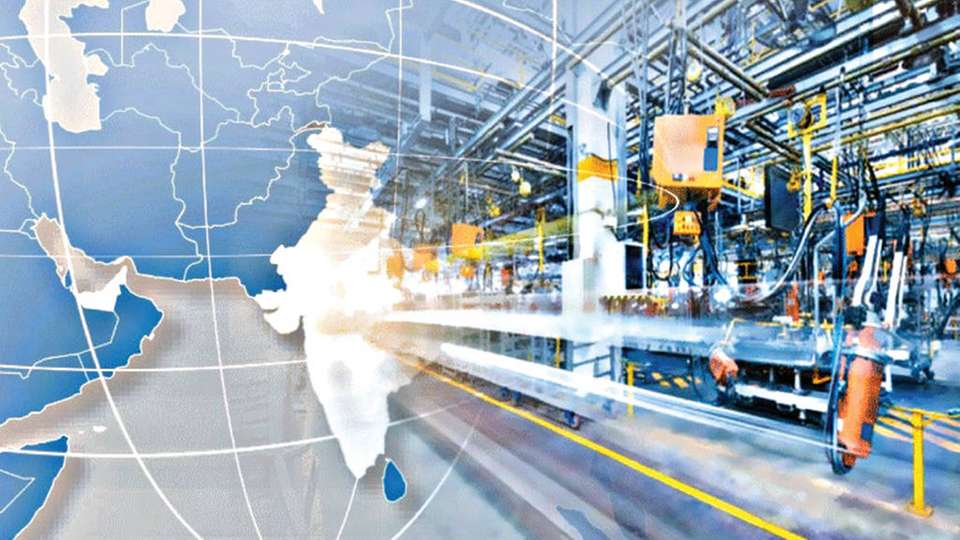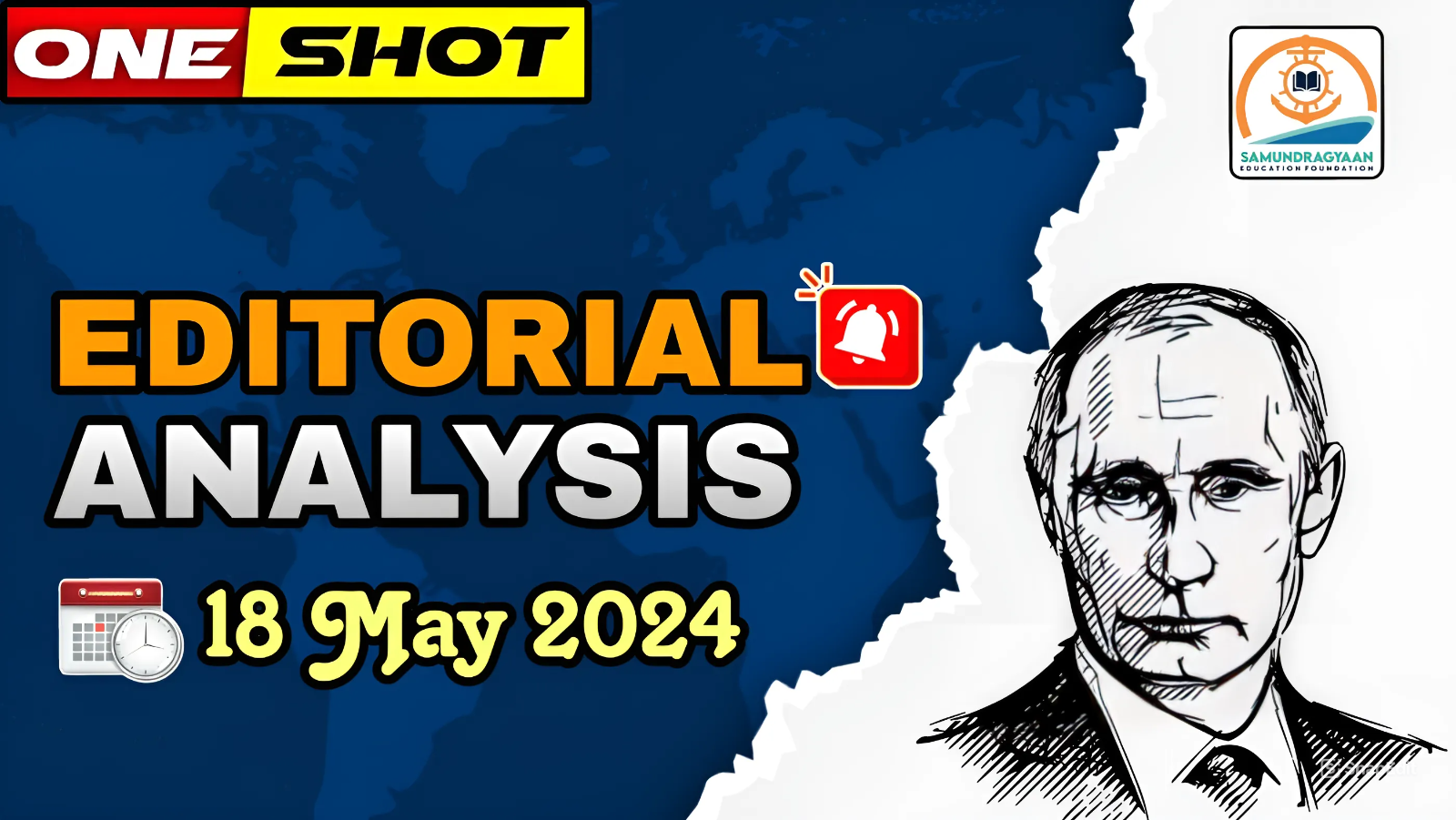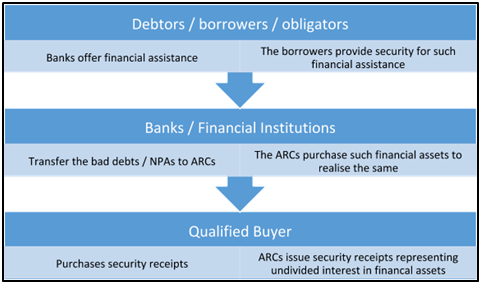Editorials & Articles : 18 May 2024

Why in news?
- Recently, Finance Minister Nirmala Sitharaman said that Indian manufacturing needs to develop greater sophistication in its products and the government will assess how to provide policy support in this endeavour. She made those remarks while addressing the annual business summit of the Confederation of Indian Industry (CII).
What’s in today’s article?
- Manufacturing in India
- Key highlights of the speech
Manufacturing in India
- Intro
- Due to performance of key sectors like automotive, engineering, chemicals, pharmaceuticals, and consumer durables, manufacturing has emerged as an integral pillar in the country’s economic growth.
- With 17% of the nation’s GDP and over 27.3 million workers, the manufacturing sector plays a significant role in the Indian economy.
- India has the capacity to export goods worth US$ 1 trillion by 2030 and is on the road to becoming a major global manufacturing hub.
- Performance – Statistics
- The Indian manufacturing sector has performed well in FY 2023-24, with a growth of 11.6%.
- Manufacturing exports have registered highest ever annual exports of US$ 447.46 billion with 6.03% growth during FY23.
- Value added in the Manufacturing market is projected to amount to US$231.5bn in 2024.
- Initiatives
- The National Manufacturing Policy aims to increase the share of manufacturing in GDP to 25 percent by 2025.
- The Production Linked Incentive (PLI) Scheme for manufacturing was launched in 2022 to develop the core manufacturing sector at par with global manufacturing standards.
- India is planning to offer incentives of up to Rs. 18,000 crore (US$ 2.2 billion) to spur local manufacturing in six new sectors including chemicals, shipping containers, and inputs for vaccines.
- Slew of measures were announced in the Union Budget 2023-24:
- Startups incorporated within a time-period and meeting other conditions can deduct up to 100% of their profits;
- The income tax rate for new co-operative societies engaged in manufacturing activities has been lowered from 22% to 15%.
- Ministry of Defence has set a target of achieving a turnover of US$ 26 billion in aerospace and defence Manufacturing by 2025, which includes US$ 5 billion exports.
- A new category of capital procurement ‘Buy {Indian-IDDM (Indigenously Designed, Developed and Manufactured)}’ has been introduced in Defence Procurement Procedure (DPP)-2016.
- By 2030, the Indian government expects the electronics manufacturing sector to be worth US$ 300 billion.
- The PLI for semiconductor manufacturing is set at Rs. 760 billion (US$ 9.71 billion), with the goal of making India one of the world’s major producers of this crucial component.
- Initiatives like Make in India, Digital India and Startup India have given the much-needed thrust to the Electronics System Design and Manufacturing (ESDM) sector in India.
- In September 2022, the National Logistics Policy was launched to ensure quick last mile delivery, end transport-related challenges.
- The Mega Investment Textiles Parks (MITRA) scheme to build world-class infrastructure will enable global industry champions to be created, benefiting from economies of scale and agglomeration. Seven Textile Parks will be established over three years.
- The ‘Operation Green’ scheme of the Ministry of the Food Processing Industry, which was limited to onions, potatoes and tomatoes, has been expanded to 22 perishable products to encourage exports from the agricultural sector.
Key highlights of the speech delivered by the Finance Minister
- Greater sophistication in manufacturing is needed
- Manufacturing must increase its share: For India to become more self-reliant, manufacturing must increase, and with the help of policies, India must increase its share in manufacturing and global value chain.
- Opportunities in India: The consumer market in India presents a $2.9 trillion opportunity.
- Also, spending on food is expected to rise to $1.4 trillion while financial services will climb to $670 billion by 2031.
- Together this would create another $1.39 trillion of opportunities.
- Also, spending on food is expected to rise to $1.4 trillion while financial services will climb to $670 billion by 2031.
- India’s demographic dividend will persist for the next 30 years: It comes with an added advantage of a historically lowest dependency ratio, means the net benefit is going to be towards more increase in consumption.
- In order to reap the benefit, skilling is being ramped up.
- India’s consistent high growth is a result of policy stability, absence of flip-flops, corruption-free decision-making combined with facilitation in legislative and legal frameworks.
- These frameworks are based on industry feedback for rapid changes in the compliance regime.

Why in News?
- In the run-up to the ongoing Lok Sabha elections, two opposition leaders were asked to modify specific parts of their speeches that they had made on Doordarshan and All India Radio (AIR) during the allotted broadcast time.
- Prasar Bharati is India’s state-run public broadcaster and the parent organisation of Doordarshan and AIR.
What’s in Today’s Article?
- What Changes were Asked from the Opposition Leaders?
- How ECI Allocates Time to Each Recognised Party for Public Broadcasting During Elections?
- What are the ECI’s Guidelines on Speech Contents for Public Broadcasting During Elections?
- What are the Concerns Raised by the Opposition Leaders?
What Changes were Asked from the Opposition Leaders?
- The CPI (Marxist) General Secretary Sitaram Yechury had to delete references to the electoral bond scheme, drop terms “communal authoritarian regime” and “draconian laws”, and replace “bankruptcy” (of governance) with “failure”.
- On the other hand, the All-India Forward Bloc (AIFB) leader G Devarajan was made to remove the word “Muslims” from his speech about the Citizenship Amendment Act.
- According to a Prasar Bharati official, the TV and radio networks were simply following rules set by the Election Commission of India (ECI).
How ECI Allocates Time to Each Recognised Party for Public Broadcasting During Elections?
- Allocation of time:
- Since the 1998 Lok Sabha elections, recognised political parties have been allowed to freely use state-owned television and radio during polls.
- The amount of time allowed to each recognised national and state party before the election campaign begins is decided by ECI.
- Amount of time:
- All national parties (put together) get a minimum of 10 hours of telecasting time on Doordarshan’s national channel, and at least 15 hours on its regional channels.
- Additionally, they get 15 hours of airing on regional AIR stations and 10 hours on the national AIR.
- All State parties (put together) get a minimum of 30 hours of telecasting time on the appropriate regional Doordarshan channel and AIR radio station.
- All national parties (put together) get a minimum of 10 hours of telecasting time on Doordarshan’s national channel, and at least 15 hours on its regional channels.
- Time allotted for the current Lok Sabha elections:
- The ECI allocated broadcast and telecast time to each of the six national parties and 59 state parties for the 2024 elections.
- For national parties, out of the 10 hours prescribed, a total of 4.5 hours (45 minutes each) was allocated in both Doordarshan and AIR.
- The remaining 5.5 hours was further allocated on the basis of vote share in the 2019 Lok Sabha elections.
- Similar formulae were followed while allocating time to state parties.
- The ECI had allocated 54 minutes each on Doordarshan and AIR to CPI (M), and 26 minutes each on the two media to AIFB.
What are the ECI’s Guidelines on Speech Contents for Public Broadcasting During Elections?
- Submit transcripts:
- Parties and their speakers are expected to submit transcripts of their speeches three to four days before recording.
- These have to be approved by the concerned authorities in the respective AIR and Doordarshan stations.
- The guidelines forbid:
- Criticism of other countries;
- Attack on religions or communities;
- Anything obscene or defamatory;
- Incitement of violence;
- Anything amounting to contempt of court;
- Attacks against the integrity of the President and judiciary;
- Anything affecting the unity, sovereignty and integrity of the nation; and
- Any criticism by the name of any person.
What are the Concerns Raised by the Opposition Leaders?
- According to the CPI(M) leader, the censorship applied to his text is a patent denial of the right to dissent in a democracy.
- The deletion of the word ‘bankruptcy’ of governance and the suggestion to replace it with ‘failure’ only endorses the authoritarian character of the government.
- According to the AIFB leader, he unsuccessfully argued for the need to use the word ‘Muslim’.
- According to him, the CAA is discriminatory to Muslims because it mentions every other minority community eligible for citizenship (except Muslims).

Why in news?
- Recently, President Vladimir Putin arrived in Beijing for a two-day state visit. During this visit, he met with President Xi Jinping at the historic Great Hall of the People, seat of power of the Chinese Communist Party. Both the leaders signed and issued a joint statement on deepening China-Russia comprehensive strategic partnership of coordination for a new era. Both leaders pledged to deepen their strategic partnership. This was Putin’s first international visit since the start of his fifth presidential term.
What’s in today’s article?
- China – Russia friendship
China – Russia friendship
- Relationship – historical background
- The relationship between China and the Soviet Union did not begin well.
- When Chairman Mao Zedong visited Moscow after the founding of the People’s Republic of China in 1949, he was made to wait for weeks for a meeting with Joseph Stalin.
- During the Cold War, China and the USSR were rivals, competing for control of the global communist movement.
- Tensions between the countries rose dangerously in the early 1960s, and they fought a brief border war in 1969.
- The relationship began to improve after the death of Mao in 1976, but remained frosty right until the collapse of the Soviet Union in 1991.
- In the post-Cold War-era, economic relations have formed the new strategic basis for Sino-Russian relations.
- China became Russia’s biggest trading partner, and the largest Asian investor in Russia.
- China views Russia as a powerhouse of raw material and a valuable market for its consumer goods.
- The hostile approach of Western countries led by USA towards Russia after the annexation of Crimea in 2014 brought Moscow closer to Beijing.
- The relationship between China and the Soviet Union did not begin well.
- Nature of relationship
- As per the leaders of both the countries, the relations between China and Russia are not opportunistic, and are not directed against anyone.
- President Xi said the China-Russia friendship was everlasting, and had become a model for a new type of international relations.
- On the other hand, a White House spokesperson had said that the China-Russia relationship was a marriage of convenience.
- Relationship against the backdrop of the Ukraine War
- China and Russia signed a no-limits strategic partnership only days before Russia invaded Ukraine on February 24, 2022.
- The Chinese role in the war has been a major concern for the West, led by the United States.
- The US believes China is supplying tech that Russia is using to build missiles, tanks, and other battlefield weapons.
- Russian imports of machine tools, computer chips, and other dual-use items from China have increased significantly.
- The sales of Chinese logistics equipment like lorries (to transport troops) and excavators (to dig trenches) to Russia have increased by four to seven times since the war began.
- China – Russia friendship: concerns for India
- For New Delhi, the Russia-China defence axis throws up critical questions.
- About 60-70% of Indian defence supplies come from Russia, and India needs regular and reliable supplies.
- This is crucial especially at a time when Indian and Chinese soldiers are locked in a standoff at the border for the last four years.
- Experts in India are also worried about a scenario in which Russia becomes a “junior partner” of China.
- Analysts claim that if war broke out between India and China, Russia’s response would be uncertain.
- During the 1962 war, the Soviet Union did not support India. In contrast, Moscow backed India during the 1971 war.
- However, today’s Russia under Vladimir Putin is different from the old Soviet Union, and its stance might vary.

Why in the News?
- RBI has identified several supervisory concerns in the functioning of Asset Reconstruction Companies (ARCs).
What’s in Today’s Article?
- About ARCs (Background, Functions, Working, Benefits, etc.)
- News Summary
About Asset Reconstruction Companies:
- An Asset Reconstruction Company (ARC) is a specialized financial institution that buys the NPAs or bad assets from banks and financial institutions so that the latter can clean up their balance sheets.
- They are regulated by the Securitization and Reconstruction of Financial Assets and Enforcement of Security Interest Act, 2002, commonly known as SARFAESI Act.
- ARCs are regulated by RBI as a Non-Banking Financial Company (NBFC) under RBI Act, 1934.They function under the supervision and control of the RBI.
- 100% Foreign Direct Investment (FDI) in ARCs is permitted under the Automatic route.
- Functions of ARCs Include:
- Acquisition of financial assets
- Change or takeover of Management / Sale or Lease of Business of the Borrower
- Rescheduling of Debts
- Enforcement of Security Interest
- Settlement of dues payable by the borrower
Background / Need for ARCs:
- The origin of ARCs is normally credited to a 1991 report on financial sector reforms by a panel chaired by former RBI Governor Narasimham.
- Accounting policies of the banking system until the 1990s didn’t include any norms for setting aside funds against bad loans.
- RBI released its first set of norms to classify bad loans or non-performing assets in October 1990.
- It led to a pile of bad loans in most public sector banks and development financial institutions was unearthed.
- The Narasimhan Panel recommended the establishment of an asset reconstruction fund or asset reconstruction company to flush bad loans out of the system.
Working of ARCs:
Benefits of ARCs:
- Improved Financial Health of Banks: ARCs help banks clean up their balance sheets by purchasing Non-Performing Assets (NPAs), allowing banks to focus on their core activities and improve their financial health.
- Specialized Management of NPAs: ARCs specialize in managing and recovering bad loans, which can be more efficient and effective than banks handling these tasks themselves.
- Enhanced Recovery Rates: With their expertise and dedicated focus, ARCs can potentially recover more funds from bad loans than banks might be able to on their own.
- Boost to Credit Flow: By reducing the burden of NPAs, ARCs help banks free up capital, which can then be used for fresh lending, thereby boosting credit flow in the economy.
- Economic Stability: Efficient management of NPAs by ARCs contributes to the overall stability of the financial system, as it helps in mitigating the risks associated with high levels of bad loans.
- Market for Distressed Assets: ARCs create a market for distressed assets, providing an exit route for banks and financial institutions looking to offload their bad loans.
- Restructuring and Revival: ARCs often work on restructuring and reviving sick units, which can help preserve jobs and support economic growth.
- Specialized Skill Set: ARCs bring in a specialized skill set and innovative recovery strategies, which can lead to better outcomes in terms of asset recovery and resolution.
RBI Flags Supervisory Concerns Over ARCs:
- The Reserve Bank of India (RBI) has asked top bosses of Asset Reconstruction Companies (ARCs) to focus on governance and adhere to ethical conduct while doing business.
- This advisory has come amidst various allegations of their indulgence in unethical practices including providing backdoor entry to defaulting promoters of insolvent companies.
- RBI’s Deputy Governor J. Swaminathan, while urging ARCs to foster a culture of integrity and ethical conduct, highlighted several supervisory concerns in the functioning of ARCs.
- He asked these entities to adopt a regulation plus approach where “there is compliance with both the letter of the regulation and also its spirit.”
- Deputy Governor M. Rajeshwar Rao, highlighted the importance of sound governance which would provide a strong foundation for the ARCs to build a robust business model.
- He also stressed the need for responsible conduct in recovery process and emphasised that ARCs should follow transparent and non-discriminatory practices.





